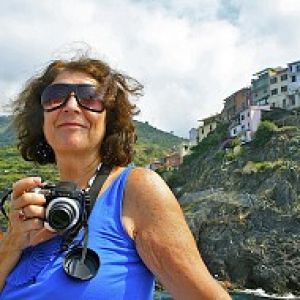The Roman City of Dougga
We had a long but very interesting day, leaving at 8am. We stopped at the Andalusian village of Testour where we attempted to see the mosque courtyard but it was locked up. We saw, from the street, the unusual clock which apparently goes backwards. Most interesting was wandering around seeing the men sitting in their big coats outside cafes, or out wearing the long, hooded woollen Berber coats, carrying their plastic bags doing the shopping. It’s a traditional village where the women are either indoors or working in the fields. However some young ones were out minus headscarves.
After a walk to stretch our legs we continued to Dougga, a UNESCO site considered to be the most beautiful in North Africa, about 3 hours from Tunis. It is situated high on a hill. At its peak in second century CE it had a population of around 10,000.
We spent 3 hours at the site but still didn’t see the hippodrome and a couple of temples. (We walked 4.5 miles during the visit). Our first stop was the heavily-restored theatre. From there we followed a paved Roman street up to the Capitol and forum. In front of the Capitol was Square of the Winds, where there was a compass-based inscription on the paving with names of all 12 winds. (We felt some of them - it was cold and windy so we were wearing our puffy coats and scarves). The Capitol, built around 166 CE, dedicated to Marcus Aurelius, is well-preserved as the Byzantines built fortifications around it. The relief sculpture on the pediment shows the previous emperor Antonius Pius being molested by a giant bird. (Most of the buildings were commissioned by wealthy family in the area).
The track continued round to the triumphal arch of Alexander Severus, built during his reign 222-235 CE. Further on was the beautiful temple of Caelestis, featuring podium and attractive columns with Corinthian capitals. Behind it was a semi-circular colonnaded portico which is unusual in Roman Africa but common in Turkey and Palestine.
We headed back (via another via) through what was the town’s residential quarter to more temples and the baths. We went down into an underground passage to see where the slaves worked at the fires to keep the water hot. We entered the “frigidarium” and went on the the “caldarium” which faced south to get the sun. We also passed the public lavatories where the men could sit and chat together while they did their business.
Our last visit was House of the Trefoil which is under reconstruction with its history of its life as the town brothel (phallus stone relief now removed further along the road) being censored. They have planted a pretty garden in an inner courtyard such as a rich family would have, with the rooms going off this.
We made a fast walk down the paved street to the arch of Septimus Severus, the emperor born in Libya, built 205CE.
Our last visit was to the Libyco-Punic Mausoleum, built in second century BCE so one of the few examples of Pre-Roman monumental buildings in Tunisia. Although it survived the Romans intact it fell to the British in 1842 when it was dismantled by Sir Thomas Reade to get the bi-lingual inscription for the British Museum where the Libyco-Phoenician was deciphered.
We finally got lunch at 2.30. The group had pork and we had an omelette. Then it was the 3 hour bus journey back, an 11 hour day but very much worth it.
Despite the 50 yards of buffet there was nothing for vegetarians - even the pastas were fish, chicken or mince. There was a pizza but with ham. I found a bread roll and some hummus to have with salad. It’s such a shame as it looks at first like there’s loads of choice. We are not buying beer or wine as it’s pointless unless we have nice food to go with it. Being in a Muslim country gives us a reason not to bother.
I have had no time to look at blip yet!
- 35
- 1

Comments
Sign in or get an account to comment.


